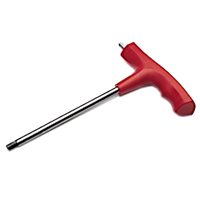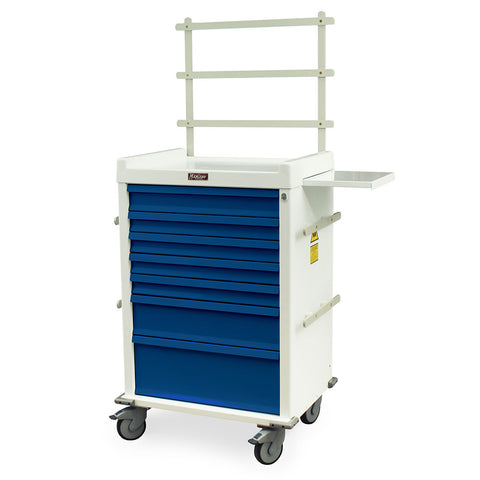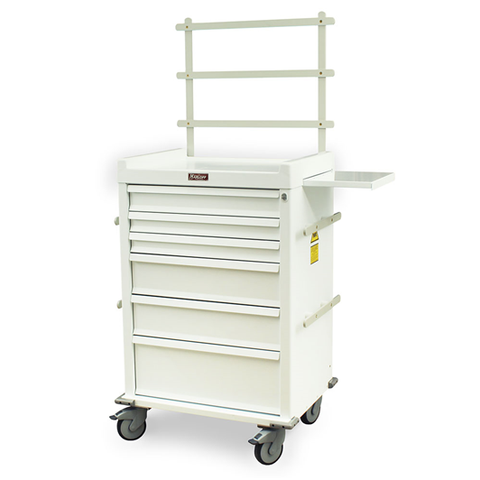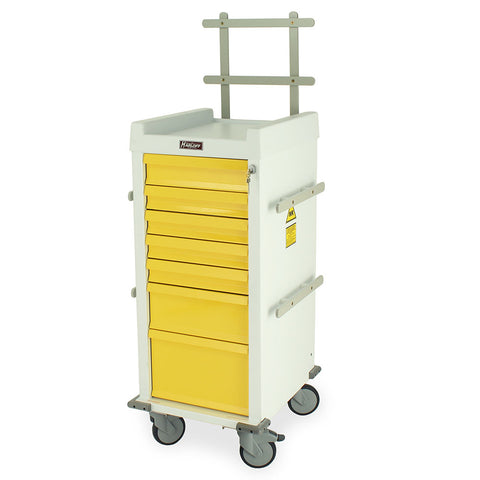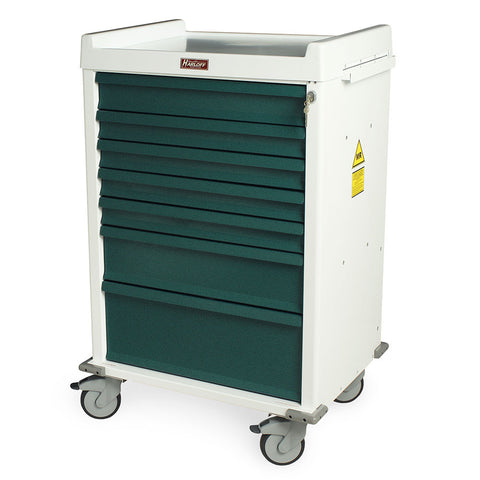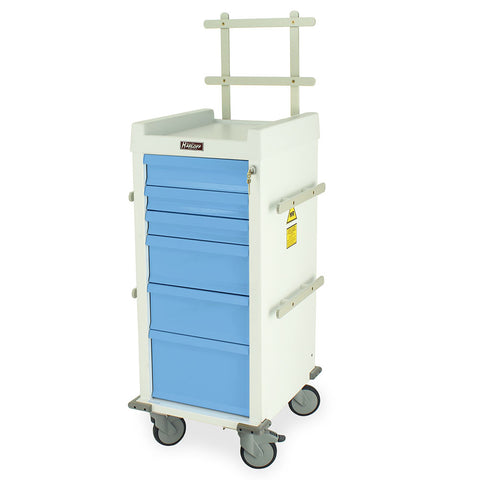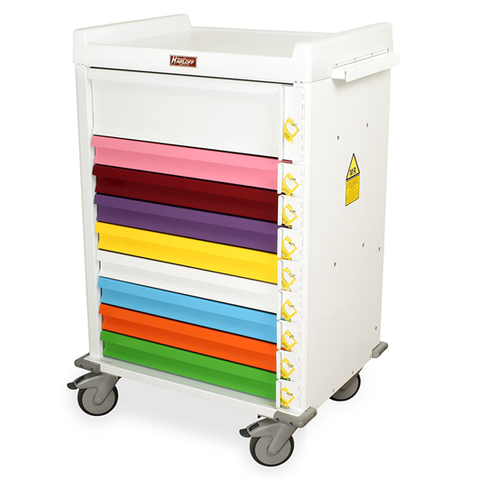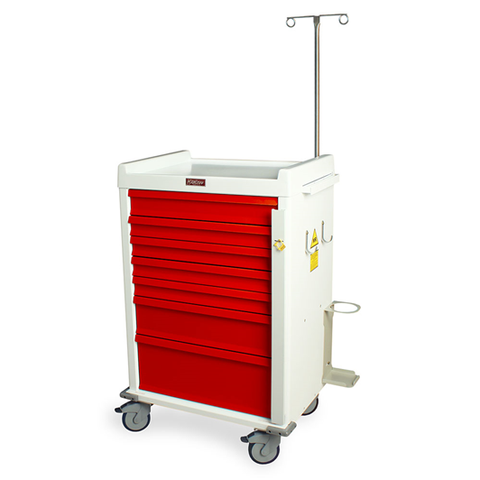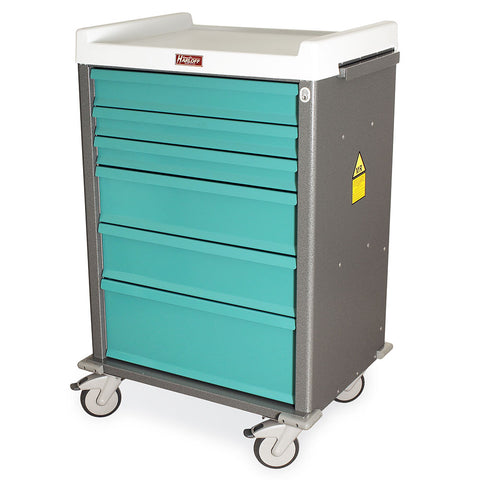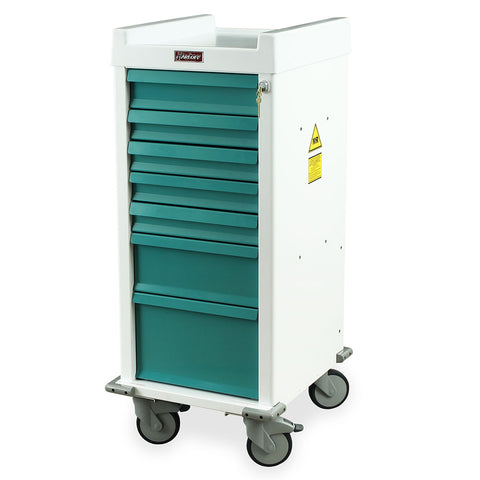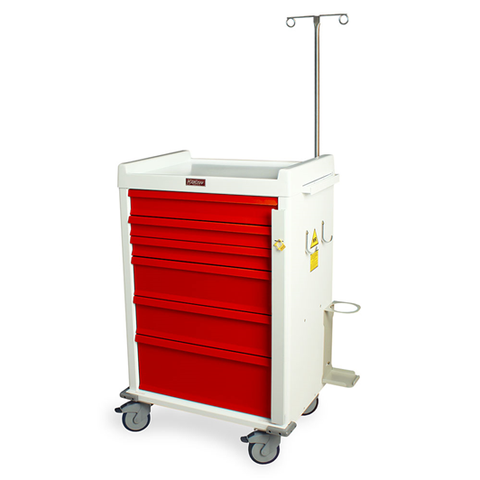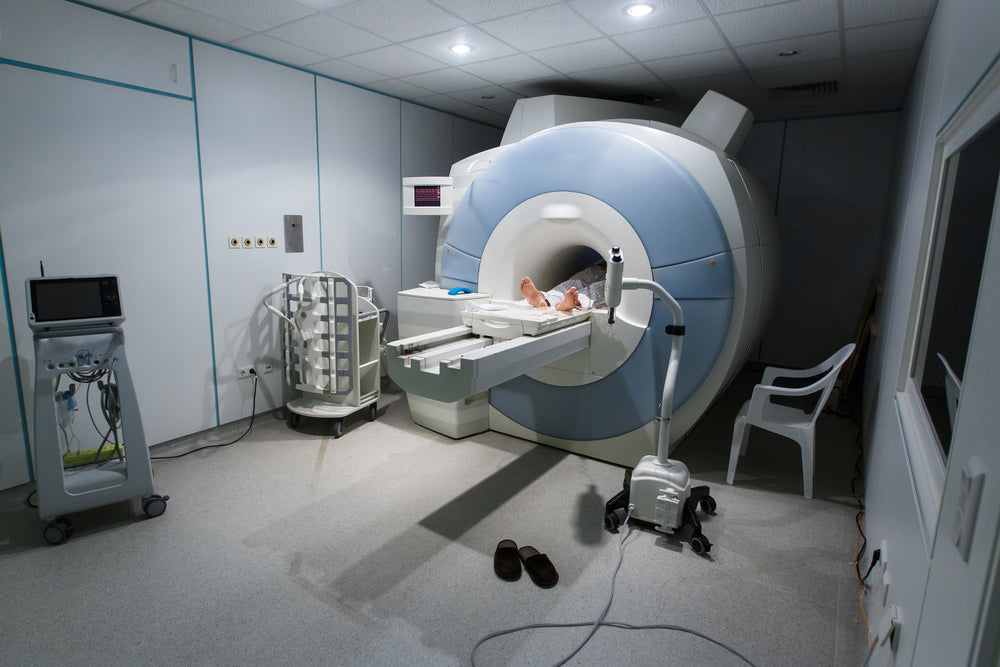
Medical imaging, particularly MRI, relies on extremely strong magnetic fields. Using the wrong materials in hospital equipment can endanger patients, staff, and imaging quality. Non-ferromagnetic medical devices are specifically designed to operate safely in MRI and other high-field environments. These include MRI-Conditional stretchers, gurneys, wheelchairs, IV poles, and monitoring equipment. Understanding the science behind these devices helps radiology departments make safe, cost-effective, and efficient decisions.
Non-ferromagnetic devices are critical in radiology because they prevent magnetic interference, maintain imaging quality, and protect patients and staff. At MRI Med, every device is tested and certified for MRI use, ensuring maximum safety and operational efficiency.
Introduction to Non-Ferromagnetic Medical Devices
What Does Non-Ferromagnetic Mean?
Non-ferromagnetic materials are metals or compounds not attracted to magnets and do not interfere with MRI magnetic fields. Common ferromagnetic metals, such as iron, cobalt, and nickel, can create severe safety hazards inside MRI suites, turning into projectiles or distorting images. Materials like aluminum, titanium, and high-grade plastics are non-ferromagnetic and widely used in hospital devices, including MRI-Conditional stretchers. These materials ensure safety while maintaining the strength, durability, and functionality required in a medical environment.
Why Non-Ferromagnetic Devices Are Critical in MRI Suites
MRI suites generate magnetic fields often exceeding 1.5 to 3 Tesla, making any ferromagnetic object a potential danger. Even small metal parts can be pulled forcefully, creating risks of injury or equipment damage. Non-ferromagnetic devices, such as MRI-Conditional gurneys, eliminate these risks while allowing smooth patient workflow. Their design supports safe transport, maintains imaging accuracy, and ensures compliance with MRI safety standards.
Common Misconceptions About Ferromagnetic and Non-Ferromagnetic Equipment
A frequent misconception is that all lightweight metals or devices without visible ferrous components are safe. Others assume labels alone guarantee MRI safety. In reality, only devices tested and certified as non-ferromagnetic should enter MRI Zone IV rooms. Certification ensures devices are safe under MRI conditions, not merely based on assumptions or visual inspection.
Magnetic Properties of Materials in Medical Equipment
Ferromagnetic vs. Paramagnetic vs. Diamagnetic Materials
Understanding how different materials react to magnetic fields is crucial:
-
Ferromagnetic materials (iron, nickel, cobalt) are strongly attracted to magnets and unsafe in MRI.
-
Paramagnetic materials are weakly attracted to magnets and must be verified for safety.
-
Diamagnetic materials, including aluminum, titanium, and plastics, are repelled slightly by magnetic fields and are safe in MRI environments.
Using MRIMed MRI wheelchairs ensures only safe materials are present in the MRI suite.
How Magnetic Fields Affect Different Metals and Alloys
Strong MRI fields can move ferromagnetic metals, creating hazards and distorting images. Non-ferromagnetic metals, such as aluminum or titanium, are unaffected. This ensures both patient safety and imaging accuracy in MRI suites.
Impact on Patient Safety and Imaging Accuracy
Non-ferromagnetic medical devices prevent injuries and eliminate image artifacts caused by magnetic interference. This improves diagnostic quality, reduces risk, and enhances confidence for patients and staff. MRIMed MRI stretchers exemplify devices designed for safety and precision in high-field environments.
Types of Non-Ferromagnetic Materials Used in Medical Devices
Aluminum, Titanium, and Specialty Alloys
Aluminum and titanium are the most common metals used in MRI-safe medical devices due to their lightweight, strong, and non-magnetic properties. Aluminum is often used for MRI-Conditional stretcher frames because it supports heavy patient loads while remaining completely non-magnetic. Titanium offers superior strength-to-weight ratio and corrosion resistance, making it ideal for devices requiring both durability and long-term reliability, such as MRI gurneys.
High-Grade Plastics and Composites
Plastics and composite materials are essential for the surfaces and body components of MRI-safe equipment. Tabletops, casings, IV pole bodies, and monitor housings are often made from high-grade, non-magnetic plastics, which prevent interference with MRI fields. These materials also improve hygiene, are easy to clean, and reduce overall device weight.
Products like MRI wheelchairs and IV poles utilize plastics for tabletops, push handles, and accessories, ensuring staff and patients can move safely without risking magnetic interference.
Testing and Certification of Materials for MR Safety
Materials intended for MRI environments must undergo rigorous testing. Standards like ASTM F2503 and FDA guidance define the methods for verifying non-ferromagnetic properties. MRIMed devices are tested for magnetic field resistance, load-bearing capability, and movement under MRI conditions to ensure safety in Zone IV environments. This includes testing wheels, casters, fasteners, and all structural components.
Certifying materials ensures that devices such as MRI-Conditional stretchers, gurneys, and wheelchairs will not interfere with imaging quality or create hazards for patients and staff.
Non-Ferromagnetic Devices in MRI Suites
MRI-Conditional Stretchers and Gurneys
Transporting patients in MRI environments requires equipment that is completely non-magnetic. MRIMed offers a variety of MRI-Conditional stretchers and gurneys designed with aluminum frames, non-magnetic wheels, and padded surfaces for safety and comfort. Adjustable height models facilitate smooth transfers from beds to scanner tables, improving workflow and minimizing strain on staff.
Every stretcher undergoes magnetic testing and ASTM F2503 verification, ensuring that they can safely be used in Zone IV MRI suites without risk of interference.
MRI-Safe Wheelchairs and Patient Transfer Equipment
Wheelchairs and patient transfer devices must navigate narrow corridors and tight MRI rooms without creating safety hazards. MRIMed provides MRI-safe wheelchairs with non-ferromagnetic frames, casters, and durable seat materials. Their lightweight construction allows staff to move patients efficiently while maintaining complete safety.
These wheelchairs and transfer devices are essential for emergency use and routine imaging, reducing patient wait times and ensuring safe transfers in high-field MRI suites.
IV Poles, Monitors, and Other Support Devices
Patient support equipment, including IV poles, vital sign monitors, and infusion stands, must also be non-magnetic to prevent accidents and imaging artifacts. MRIMed offers non-magnetic IV poles and monitoring equipment with aluminum or high-grade plastic construction. These devices maintain stability under patient load, allow smooth mobility, and operate safely near strong MRI magnetic fields.
Properly designed non-ferromagnetic support equipment ensures that MRI scans remain uninterrupted, and patient safety is preserved.
Design Considerations for Non-Ferromagnetic Devices
Structural Integrity and Weight Capacity
Non-ferromagnetic devices are engineered to match or exceed the load-bearing capabilities of conventional ferromagnetic equipment. For instance, MRIMed MRI-Conditional stretchers support patients up to 500 lbs, providing full functionality while remaining non-magnetic. Structural reinforcements are carefully designed using aluminum and specialty alloys to ensure durability and patient safety.
Non-Magnetic Wheels, Casters, and Fasteners
Wheels, casters, and fasteners are often overlooked but are critical for safety. MRIMed uses non-magnetic casters and fasteners in all MRI-safe equipment, reducing friction, increasing maneuverability, and preventing magnetic hazards. These components are tested to withstand frequent use while maintaining smooth movement in tight MRI corridors.
Ergonomics and Patient Comfort
Patient comfort is essential during imaging procedures. Non-ferromagnetic equipment incorporates padded surfaces, adjustable heights, and ergonomically designed handles. MRIMed ensures that all MRI-safe stretchers, gurneys, and wheelchairs provide both comfort and stability, minimizing stress for patients and staff during transfers.
Testing and Certification for MRI Safety
ASTM F2503 Standards Explained
ASTM F2503 is the global standard for labeling MRI safety of medical devices. It classifies devices as MR Safe, MR Conditional, or MR Unsafe, depending on their behavior in magnetic fields. MRIMed ensures all MRI-Conditional stretchers, gurneys, and wheelchairs meet or exceed these standards, providing healthcare facilities with reliable guidance for safe MRI suite operations.
Using ASTM-certified devices minimizes the risk of accidental projectile hazards and prevents imaging artifacts that could compromise diagnostic accuracy.
How Manufacturers Test Devices in MRI Environments
Testing involves exposing devices to strong MRI magnetic fields under controlled conditions. This includes:
-
Weight Load Simulations: Ensuring stretchers and gurneys maintain structural integrity under patient weight.
-
Movement Assessments: Verifying that wheels, casters, and adjustable parts operate smoothly without magnetic interference.
-
Magnetic Field Interaction: Confirming no components are attracted to MRI magnets or cause imaging distortions.
All MRIMed products, including MRI wheelchairs and IV poles, undergo these rigorous tests before being cleared for Zone IV use.
Labeling: MR Safe, MR Conditional, MR Unsafe
Labels provide clear guidance on where equipment can be safely used:
-
MR Safe: No risk in any MRI environment.
-
MR Conditional: Safe under specified conditions (e.g., field strength, positioning).
-
MR Unsafe: Must never enter MRI zones.
MRIMed labels every device according to ASTM F2503, helping staff quickly identify safe equipment and preventing costly or dangerous mistakes.
Operational Benefits of Non-Ferromagnetic Devices
Enhanced Patient Safety and Reduced Risk
Non-ferromagnetic devices eliminate the projectile risk from strong MRI magnetic fields. By using MRIMed’s MRI-Conditional stretchers, wheelchairs, and IV poles, hospitals reduce the likelihood of injuries to patients and staff while maintaining full operational efficiency.
Improved Workflow and Imaging Efficiency
Lightweight, maneuverable devices streamline patient transport, enabling faster room turnover and shorter scan times. MRIMed’s non-magnetic equipment supports smooth workflow from emergency admissions to routine imaging, ensuring healthcare teams can provide timely care without safety concerns.
Long-Term Cost Savings Through Durability
Investing in non-ferromagnetic equipment reduces maintenance and replacement costs. Aluminum and titanium frames, high-grade plastics, and durable non-magnetic wheels extend the lifespan of devices like MRIMed MRI-Conditional gurneys. This longevity minimizes capital expenditure while maintaining a safe MRI suite environment.
Challenges in Implementing Non-Ferromagnetic Devices
Identifying Non-Ferromagnetic Devices in Existing Inventory
Many older hospital devices are unlabeled or partially labeled. Magnetic testing tools and careful documentation are essential to verify non-ferromagnetic status. MRIMed provides full safety documentation for all devices, making integration into MRI workflows straightforward.
Staff Training and Awareness
Staff must understand MRI safety zones and device limitations. Proper training ensures that stretchers, wheelchairs, and support devices are used safely. MRIMed offers guidance on handling, positioning, and inspecting devices for maximum safety.
Maintenance and Longevity Considerations
Regular inspections, lubrication of wheels, and cleaning of plastic and metal surfaces extend the lifespan of MRI-safe equipment. MRIMed recommends periodic checks of adjustable components, caster movement, and padding, ensuring equipment remains safe and fully functional over time.
Choosing the Right Non-Ferromagnetic Equipment
Evaluating Materials and Construction
Choose devices with certified aluminum, titanium, or high-grade plastic construction. MRIMed products are rigorously tested for strength, non-ferromagnetic properties, and durability. Ensure all items have ASTM F2503 certification to guarantee safety in Zone IV environments.
Matching Devices to MRI Suite Workflows
Select equipment that aligns with your MRI suite layout, patient demographics, and procedural requirements. MRIMed offers a range of MRI stretchers, gurneys, and wheelchairs to fit diverse clinical settings, from emergency departments to outpatient imaging centers.
Vendor Certification and Long-Term Value
MRIMed provides full MR safety documentation, warranties, and post-sale support, ensuring healthcare facilities invest in equipment that offers long-term operational efficiency and safety. Verified vendor certification prevents unexpected compliance issues and enhances staff confidence in device use.
FAQ:
-
How can I tell if a device is non-ferromagnetic?
Check ASTM F2503 labels and perform magnetic testing if necessary. MRIMed provides verified documentation for every product.
-
Are all aluminum or plastic devices safe in MRI suites?
Not all. Only devices tested and certified for MR environments, like MRI wheelchairs and IV poles, are safe for Zone IV use.
-
How often should non-ferromagnetic devices be tested?
Routine inspections are recommended at least annually or as specified by the manufacturer to ensure ongoing safety and compliance.
-
Can non-ferromagnetic devices interfere with MRI scans?
Properly tested devices do not interfere with imaging. MRIMed equipment is engineered to prevent magnetic interference and maintain high-quality scans.
-
Why is it important to buy from trusted suppliers like MRIMed?
Trusted suppliers ensure ASTM F2503 compliance, full documentation, and thoroughly tested equipment. MRIMed’s non-ferromagnetic devices deliver reliability, durability, and patient safety, reducing liability and operational risks.
